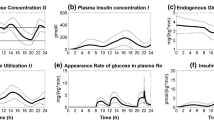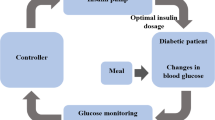Abstract
Closed-loop controllers for insulin pumps have been on the market for some time. It has been shown that modified PID or MPC control algorithms are best suited for artificial pancreas. However, due to nonnegative control values only and relatively slow dynamics of the response to insulin input, they are not well equipped to deal with hypoglycemia induced by a physical effort. This paper is focused on that aspect of blood glucose control. Two alternative solutions are proposed and compared. The first one is based on feedforward, with additional information about future physical effort entered by the user. The second approach uses an additional control in the form of glucagon. Simulation is run for a fixed scenario of three meals and additional physical effort that affects the insulin-glucose system for a cohort of virtual patients, for whom model parameters were sampled. Performance of control systems is evaluated with several quality indicators.
Access this chapter
Tax calculation will be finalised at checkout
Purchases are for personal use only
Similar content being viewed by others
References
American diabetes association. 6. glycemic targets. Diabetes Care 40(Supplement 1), S48–S56 (2016). https://doi.org/10.2337/dc17-S009
Bergman, R.: The minimal model: yesterday, today and tomorrow. In: R. Bergman, J. Lovejoy (eds.) The minimal model approach and determinants of glucose tolerance. Louisiana University Press, Baton Rouge, USA (1997)
Bertachi, A., Ramkissoon, C.M., Bondia, J., Vehí, J.: Automated blood glucose control in type 1 diabetes: a review of progress and challenges. Endocrinología, Diabetes y Nutrición 65(3), 172–181 (2018). https://doi.org/10.1016/j.endinu.2017.10.011
Blauw, H., Onvlee, A.J., Klaassen, M., van Bon, A.C., DeVries, J.H.: Fully closed loop glucose control with a bihormonal artificial pancreas in adults with type 1 diabetes: an outpatient, randomized, crossover trial. Diab. Care 44(3), 836–838 (2021). https://doi.org/10.2337/dc20-2106
van Bon, A.C., Luijf, Y.M., Koebrugge, R., Koops, R., Hoekstra, J.B., DeVries, J.H.: Feasibility of a portable bihormonal closed-loop system to control glucose excursions at home under free-living conditions for 48 hours. Diab. Technol. Ther. 16(3), 131–136 (2014). https://doi.org/10.1089/dia.2013.0166
Brun, J., Guintrand-Hugret, R., Boegner, C., Bouix, O., Orsetti, A.: Influence of short-term submaximal exercise on parameters of glucose assimilation analyzed with the minimal model. Metabolism 44(7), 833–840 (1995). https://doi.org/10.1016/0026-0495(95)90234-1
Colmegna, P.H., Bianchi, F.D., Sanchez-Pena, R.S.: Automatic glucose control during meals and exercise in type 1 diabetes: Proof-of-concept in silico tests using a switched LPV approach. IEEE Control Syst. Lett. 5(5), 1489–1494 (2021). https://doi.org/10.1109/lcsys.2020.3041211
Herrero, P., Georgiou, P., Oliver, N., Reddy, M., Johnston, J., Toumazou, C.: A composite model of glucagon-glucose dynamics for in silico testing of bihormonal glucose controllers. J. Diab. Sci. Technol. 7(4), 941–951 (2013). https://doi.org/10.1177/193229681300700416
Hirsch, I.: Type 1 diabetes mellitus and the use of flexible insulin regimens. Am. Family Phys. 60(8), 2343–2356 (1999)
Hovorka, R., et al.: Nonlinear model predictive control of glucose concentration in subjects with type 1 diabetes. Phys. Measur. 25(4), 905–920 (2004)
Briscoe, V., Davis, S.: Hypoglycemia in Type 1 Diabetes. In: Type 1 Diabetes in Adults, pp. 203–220. CRC Press, Boca Raton (2007)
Lehmann, E., Deutsch, T.: A physiological model of glucose-insulin interaction in type 1 diabetes mellitus. J Biomed. Eng. 14, 235–242 (1992)
Matejko, B., Kukułka, A., Kieć-Wilk, B., Stąpór, A., Klupa, T., Malecki, M.T.: Basal insulin dose in adults with type 1 diabetes mellitus on insulin pumps in real-life clinical practice: a single-center experience. Adv. Med. 2018, 1–5 (2018). https://doi.org/10.1155/2018/1473160
Paiva, H.M., Keller, W.S., da Cunha, L.G.R.: Blood-glucose regulation using fractional-order PID Control. J. Control Autom. Electr. Syst. 31(1), 1–9 (2019). https://doi.org/10.1007/s40313-019-00552-0
Śmieja, J., Gałuszka, A.: Rule-based pid control of blood glucose level. In: A. Świerniak, J. Krystek (eds.) ’Teoria i zastosowania. T. 2’. Wydawnictwo Politechniki Ślaskiej, Gliwice (2018)
Tabassum, M.F., Farman, M., Naik, P.A., Ahmad, A., Ahmad, A.S., Hassan, S.M.: Modeling and simulation of glucose insulin glucagon algorithm for artificial pancreas to control the diabetes mellitus. Netw. Model. Anal. Health Inf. Bioinf. 10(1), 1–8 (2021). https://doi.org/10.1007/s13721-021-00316-4
Taleb, N., et al.: Efficacy of single-hormone and dual-hormone artificial pancreas during continuous and interval exercise in adult patients with type 1 diabetes: randomised controlled crossover trial. Diabetologia 59(12), 2561–2571 (2016). https://doi.org/10.1007/s00125-016-4107-0
Taleb, N., Haidar, A., Messier, V., Gingras, V., Legault, L., Rabasa-Lhoret, R.: Glucagon in artificial pancreas systems: potential benefits and safety profile of future chronic use. Diabetes Obes. Metab. 19(1), 13–23 (2016). https://doi.org/10.1111/dom.12789
Wendt, S., et al.: Model of the glucose-insulin-glucagon dynamics after subcutaneous administration of a glucagon rescue bolus in healthy humans. In: Proceedings of The American Diabetes Association’s 76th Scientific Sessions. The American Diabetes Association, New Orleans, Louisiana, United States (2016)
Global Report on Diabetes. World Health Organisation (2016)
Guidelines on second- and third-line medicines and type of insulin for the control of blood glucose levels in non-pregnant adults with diabetes mellitus. World Health Organisation, Geneva (2018)
Acknowledgement
This work was supported by the SUT internal grant for young researchers (AW) and the SUT internal grant 02/040/BK_21/1022.
Author information
Authors and Affiliations
Corresponding author
Editor information
Editors and Affiliations
Rights and permissions
Copyright information
© 2022 The Author(s), under exclusive license to Springer Nature Switzerland AG
About this paper
Cite this paper
Śmieja, J., Wyciślok, A. (2022). Two-Dimensional vs. Scalar Control of Blood Glucose Level in Diabetic Patients. In: Pietka, E., Badura, P., Kawa, J., Wieclawek, W. (eds) Information Technology in Biomedicine. ITIB 2022. Advances in Intelligent Systems and Computing, vol 1429. Springer, Cham. https://doi.org/10.1007/978-3-031-09135-3_43
Download citation
DOI: https://doi.org/10.1007/978-3-031-09135-3_43
Published:
Publisher Name: Springer, Cham
Print ISBN: 978-3-031-09134-6
Online ISBN: 978-3-031-09135-3
eBook Packages: Intelligent Technologies and RoboticsIntelligent Technologies and Robotics (R0)




